View in other NatureServe Network Field Guides
NatureServe
Montana
Utah
Wyoming
Idaho
Wisconsin
British Columbia
South Carolina
Yukon
California
New York
Railroad Canyon Wild Buckwheat - Eriogonum soliceps
State Rank Reason (see State Rank above)
See rank details. Described as a new species in 2004 (Reveal and Bjork).
- Details on Status Ranking and Review
Population Size
Score1 - Moderate: Generally 10,000-100,000 individuals.
Range Extent
Score3 - Local Endemic or Very Small Montana Range: Generally restricted to an area <10,000 sq. miles (equivalent to the combined area of Phillips and Valley Counties) or <6 Sub-basins (4th code watersheds) Range-wide OR limited to one Sub-basin in Montana
Area of Occupancy
Score1 - Moderate: Generally occurring in 11-25 Subwatersheds (6th Code HUC’s).
CommentAdditional populatons are likely to be found with additional survey work.
Environmental Specificity
Score1 - Moderate: Species is restricted to a specific habitat that is more widely distributed or to several restricted habitats and is typically dependent upon relatively unaltered, good-quality habitat (C Values of 5-7).
Trends
Score0-1 - Stable to Minor Declines:
CommentTrends unknown, though populations are likely stable or experiencing only minor declines.
Threats
Score0-1 - Low to Medium.
CommentPotential threats do not appear to be widespread, though negative impacts to speciific occurrences or habitat quality are possible from various land uses. Its preference for sparsely-vegetated habitats tends to reduce the chance of impacts.
Intrinsic Vulnerability
Score0-1 - Low to Moderate Vulnerability.
CommentPollinator specificity and requirements are unknown.
Raw Conservation Status Score
Score
6 to 9 total points scored out of a possible 19.
General Description
Cushion-forming perennial from a woody, branched caudex. Flowering stems erect, 1–6 cm, covered in old leaf bases below. Leaves all basal, the blades oblanceolate, tomentose, 5–15 mm long. Inflorescence a solitary involucre; bracts absent; involucre tomentose, 2–3 mm long with 5 erect lobes, solitary. Flowers 1–3 mm long, white, cup-shaped; tepals glabrous, punctate, similar in shape; stamens slightly exserted. Achenes 2–3 mm long (
Lesica et al. 2012. Manual of Montana Vascular Plants. BRIT Press. Fort Worth, TX).
Phenology
Flowering in June and July.
Diagnostic Characteristics
Eriogonum soliceps is most similar and probably closely related to E. mancum. It differs from this species and all other Eriogonum in a very unusual suite of characteristics. These are the single involucre per peduncle and lack of bracts (one of only two perennial Eriogonum species known to have these characteristics). It is further distinguished from E. mancum in that the bracteoles are glandular, the perianths have a prominently pustular keel, the peduncles are narrower and less tomentose, and the achene is more pungently textured. With Eriogonum cespitosum, it shares the solitary involucres and lack of bracts, but unlike that species, E. soliceps has (4) 5 (6) involucre lobes that are short and not reflexed.
Species Range
Montana Range
Range Descriptions
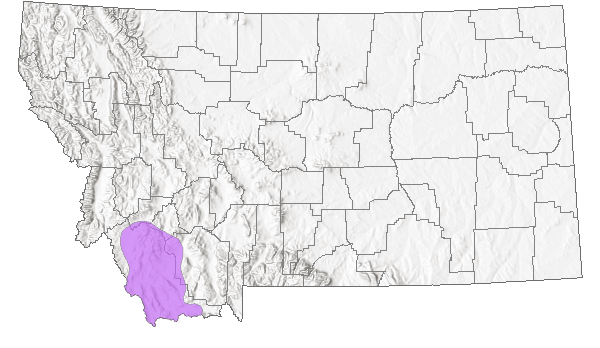
 Native
Native
Range Comments
Local endemic of southwest Montana and adjacent Lemhi County, Idaho.
Observations in Montana Natural Heritage Program Database
Number of Observations: 29
(Click on the following maps and charts to see full sized version)
Map Help and Descriptions
Relative Density
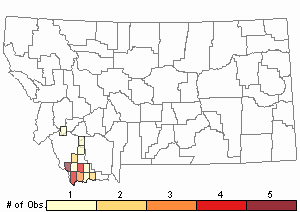
Recency
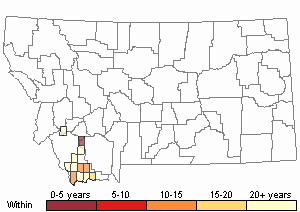
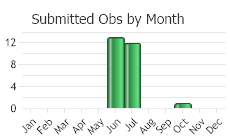
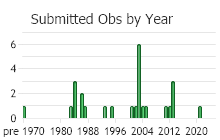
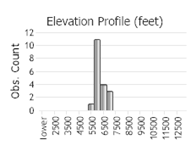 (Observations spanning multiple months or years are excluded from time charts)
(Observations spanning multiple months or years are excluded from time charts)
Habitat
Montana's Rape Creek population occupies gentle southern slopes on coarse alkaline clay derived from calcareous slate. Soils are dry and vegetation is sparse, dominated by Artemisia tridentata ssp. wyomingensis, Phlox muscoides, and Chrysothamnus nauseosus. Associates include Achnatherum hymenoides, Monolepis nuttalliana, Stenotus acaulis, and Carex duriuscula. Other Montana collections are from open slopes and ridgetops with dry stony or shallow soil, often from limestone. Varied associates include Cercocarpus ledifolius, Oxytropis besseyi, O. campestris, Lesquerella alpina, Haplopappus acaulis, Phlox hoodii, Penstemon aridus, Artemisia nova and Ivesia gordonii.
National Vegetation Classification System Groups Associated with this Species
Forest and Woodland
Low Elevation - Xeric Forest and Woodland
Montane - Subalpine Forest and Woodland
Shrubland
Foothills - Montane Shrubland
Sagebrush Shrubland
Sparse and Barren
Sparse and Barren
Ecology
Habitats for this plant tend to be somewhat protected, with vegetation limited to a few species adapted to the poor soils. Like most species of
Eriogonum, E. soliceps may readily move into disturbed areas (Reveal & Bjork 2004).
POLLINATORS The following animal species have been reported as pollinators of this plant species or its genus where their geographic ranges overlap:
Bombus bifarius,
Bombus centralis,
Bombus flavifrons,
Bombus huntii,
Bombus melanopygus,
Bombus mixtus,
Bombus ternarius,
Bombus occidentalis,
Bombus insularis, and
Bombus flavidus (Thorp et al. 1983, Koch et al. 2012, Williams et al. 2014).
Management
No populations have been noted as impacted by the light cattle grazing and trampling that has been observed at surveyed localities. Exotic weeds were scarce in these habitats and are not currently a threat (Reveal & Bjork 2004). However, the barren slope habitat could be vulnerable to ATV use. Surveys are needed to determine the full range of this species in Montana, as well as the status of historically documented populations and any threats or management needs.
Stewardship Responsibility
Threats or Limiting Factors
STATE THREAT SCORE REASON
Threat impact not assigned because threats are not known (MTNHP Threat Assessment 2021).
References
- Literature Cited AboveLegend:
 View Online Publication
View Online Publication Koch, J., J. Strange, and P. Williams. 2012. Bumble bees of the western United States. Washington, DC: USDA Forest Service, Pollinator Partnership. 143 p.
Koch, J., J. Strange, and P. Williams. 2012. Bumble bees of the western United States. Washington, DC: USDA Forest Service, Pollinator Partnership. 143 p. Lesica, P., M.T. Lavin, and P.F. Stickney. 2012. Manual of Montana Vascular Plants. Fort Worth, TX: BRIT Press. viii + 771 p.
Lesica, P., M.T. Lavin, and P.F. Stickney. 2012. Manual of Montana Vascular Plants. Fort Worth, TX: BRIT Press. viii + 771 p. MTNHP Threat Assessment. 2021. State Threat Score Assignment and Assessment of Reported Threats from 2006 to 2021 for State-listed Vascular Plants. Botany Program, Montana Natural Heritage Program, Helena, Montana.
MTNHP Threat Assessment. 2021. State Threat Score Assignment and Assessment of Reported Threats from 2006 to 2021 for State-listed Vascular Plants. Botany Program, Montana Natural Heritage Program, Helena, Montana. Thorp, R.W., D.S. Horning, and L.L. Dunning. 1983. Bumble bees and cuckoo bumble bees of California (Hymenoptera: Apidae). Bulletin of the California Insect Survey 23:1-79.
Thorp, R.W., D.S. Horning, and L.L. Dunning. 1983. Bumble bees and cuckoo bumble bees of California (Hymenoptera: Apidae). Bulletin of the California Insect Survey 23:1-79. Williams, P., R. Thorp, L. Richardson, and S. Colla. 2014. Bumble Bees of North America. Princeton, NJ: Princeton University Press. 208 p.
Williams, P., R. Thorp, L. Richardson, and S. Colla. 2014. Bumble Bees of North America. Princeton, NJ: Princeton University Press. 208 p.
- Additional ReferencesLegend:
 View Online Publication
View Online Publication
Do you know of a citation we're missing? Lesica, P., M.T. Lavin, and P.F. Stickney. 2022. Manual of Montana Vascular Plants, Second Edition. Fort Worth, TX: BRIT Press. viii + 779 p.
Lesica, P., M.T. Lavin, and P.F. Stickney. 2022. Manual of Montana Vascular Plants, Second Edition. Fort Worth, TX: BRIT Press. viii + 779 p. Quire, R.L. 2013. The sagebrush steppe of Montana and southeastern Idaho shows evidence of high native plant diversity, stability, and resistance to the detrimental effects of nonnative plant species. M.Sc. Thesis. Bozeman, MT: Montana State University. 124 p.
Quire, R.L. 2013. The sagebrush steppe of Montana and southeastern Idaho shows evidence of high native plant diversity, stability, and resistance to the detrimental effects of nonnative plant species. M.Sc. Thesis. Bozeman, MT: Montana State University. 124 p. Reveal, J.L. and C.R. Bjork. 2004. Eriogonum soliceps (Polygonaceae: Eriogonoideae), a new species from east-central Idaho and southwestern Montana. Brittonia 56(4): 295-298.
Reveal, J.L. and C.R. Bjork. 2004. Eriogonum soliceps (Polygonaceae: Eriogonoideae), a new species from east-central Idaho and southwestern Montana. Brittonia 56(4): 295-298.
- Web Search Engines for Articles on "Railroad Canyon Wild Buckwheat"





